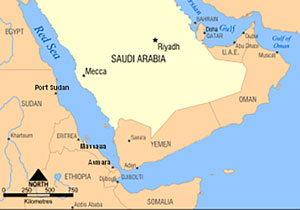
Arabian Peninsula
Understanding the Global Economic and Security Threat
Last week in my article on Yemen and the Houthi rebels, I gave some statistics on Yemen in the first paragraph. Ita population is 34.5 million. More than 99 percent are Muslims, of which about 58 percent are Sunni Muslims and 42 percent are Shia Muslims. The Shia Muslims are overwhelmingly of the Zaydi branch, which is closely associated with the Houthi rebels. The average annual price adjusted GDP is only $2,053. The literacy rate is about 70 percent.
A few days after I had written the article, I found a very informative interview of Professor Juan Cole, a history professor at the University of Michigan, who is very knowledgeable about the Middle East and the Red Sea and Persian Gulf. According to Cole, about 12 percent of world trade moves through the Red Sea. Close to 30 percent of maritime trade moves through the Red Sea, and about 10 percent of petroleum products move through the Red Sea. The Red Sea is only about 18 miles wide at it narrow southern end connecting to the Gulf of Aden. Routing shipping around the Cape of Good Hope in southern Africa rather than through the Red Sea and Suez Canal increases the cost by 180 percent, and that does not include the increase in shipping insurance. In fact, many insurers are no longer willing to insure ships traveling in the Red Sea.
The narrow southern entrance of the Red Sea is fortunately controlled by United Arab Emirates (UAE) forces and anti-Houthi Yemeni militias. However, the Houthi can easily reach almost all of the Red Sea by Iranian supplied rockets and UAV drones.
According to Cole and others, although the Houthis control less than a third of Yemen, this third has 80 percent of the population. Although Yemen has much coastline on the Gulf of Aden and the Red Sea, the average elevation for the whole country is about 6,600 feet. The elevation of the Houthi occupied capital, Sanaa, is 7,320 feet.
A large part of eastern Yemen is part of the most desolate desert in the world. Saudis, UAE Emiratis, Omanis, and Yemenis refer to this as the “Empty Quarter,” in Arabic, Rub’ al Khali. It covers almost a third, 250,000 square miles of the Arabian Peninsula. Average high temperatures in July and August reach 124 degrees Fahrenheit. It is inhabited only by a few roving nomads. The Omanis completed a road going through it to Saudi Arabia in 2021. Some have speculated that the “Empty Quarter” might have once been the Garden of Eden, but now blighted with huge sand dunes and an intolerably hot and dry climate. The northern portion of the Empty Quarter in Saudi Arabia has the largest oil field in the world.
The UAE is located on the opposite side of the Arabian Peninsula on the Persian Gulf and Gulf of Oman. Yet it is playing a huge role in the Yemen Civil War, because it is has a vital interest in keeping its petroleum exports and other shipping going through the Red Sea. Hence it is allied with Saudi Arabia with the same objectives and against disruptive Houthi influence and actions. The UAE has troops in Yemen but it operates mainly through training 200,000 Yemeni men, who operate in anti-Houthi secessionist militias in Aden and along the coast and mountainous interior of southern Yemen.
The UAE is located just north of the Empty Quarter on the southeast coast of the Arabian Peninsula and just south of Muslim Brotherhood controlled Qatar. It has a population of about 10.0 million, about the same Sweden or North Carolina.
Only about 12 percent of the UAE’s 10.0 million population are native Arab Emiratis. Over 59 percent are South Asian immigrants, of which the majority, 38 percent, are from India. The UAE’s huge and extremely profitable oil and gas industry and accompanying explosion of financial businesses have required massive permanent and temporary immigration. The population is 76 percent Muslim, of whom 85 percent are Sunni, which is the religion of the Arab Emirates who govern the UAE. Christianity is tolerated and has grown to13 percent. There are about 100,000 British expatriates and many Americans, Canadians, and Western European nationals working and residing in the UAE. Islamic Law dominates much of the culture, but the UAE has made many allowances for its non-Muslim migrant workers. LGBT, however, is not welcome, but the Quranic and Muhammadan death penalty is rarely if ever enforced. Because of its mainly male and seasonal migrant worker force, the UAE has a severe gender imbalance with 2.2 males for every female.
The UAE is a federation of seven emirates, each ruled by an absolute monarch. The emirates are: Abu Dhabi, Ajman, Dubai, Fujairah, Ras Al Khaimah, Sharjah, and Umm Al Quwain. The seven monarchs form the Federal Supreme Council, which elects a president and two vice presidents from its members. The current president is Sheikh Mohamed bin Zayed. By tradition, the president is always the ruler of Abu Dhabi, and one vice president is the ruler of Dubai, who is also the prime minister. Sheik Mohammed bin Rashid Al Maktoum is the current prime minister.
The UAE is small in area, a little over 32,000 square miles, but fabulously wealthy. In 2023, the price adjusted GDP per capita was nearly $89,000, the sixth highest in the world. Total price adjusted GDP was $895 billion. The UAE’s nominal GDP is 39 percent higher than that of Iran. The UAE has become a major financial center, and only 26 percent of its GDP is directly from the oil and gas industry. Finance, media, and technology commerce have exploded in the last 50 years.
The UAE, which is on the western coast of the Persian Gulf, across from Shia Muslim Iran, has the third largest economy in the Middle East. Saudi Arabia is number one, and Israel is number two. Egypt if fourth, and Iran is fifth. According to Cole, more than 30 percent of worldwide maritime oil and gas trade goes the Persian Gulf. A substantial part of this comes from the UAE and then moves through the Red Sea and the Suez Canal. Although located on the Persian Gulf, the UAE’s vital national economic interest is clear. The passage of maritime trade through the Red Sea must not be disrupted.
Eighty-eight percent the population of the UAE is urban. The capital of the UAE is Abu Dhabi with 1.8 million people. Its largest city is Dubai with 3,6 million. Sharjah has 1.4 million. Al Ain with 847,000 is also in the Abu Dhabi emirate. These are gleaming modern cities filled with fantastic architectural design. However, the average daily high temperature during July and August in Dubai is 106 degrees Fahrenheit. Fortunately, the UAE’s great wealth makes air conditioning abundant and affordable.
The UAE has been described as “Little Sparta” by former Trump Secretary of Defense James Mattis. It has an army of 44,000, an air force of 4,500, a navy of 2,500, and 12,000 men in the Presidential Guard. Its military budget in 2022 was over $4.0 billion. The UAE Navy has 46 ships and the UAE Air Force has 386 aircraft. The UAEAF has three F-16 squadrons armed with modern missiles.
Attempted Houthi strikes against bulk container cargo ships extend from the narrow Mandab Straight at the southern end of the Red Sea northward along the western coast of Houthi held territory in Yemen. Ground-launched Houthi missiles generally have an effective potential strike range up to 480 miles. Their UAV drone effective strike range is about 120 miles. Some attempted strikes have been aimed into the Aden Gulf before entering the Mandab Straight. According to the BBC, one U.S. operated container ship, the Genco Picardy, was struck on January 17, but the damage was not severe. On January 10, the Houthis had made a bold attack against the US aircraft carrier Dwight Eisenhower and four escort destroyers, but all 21 missiles and drones were shot down or defeated by electronic countermeasures.
On February 3, U.S. and UK aircraft attempted strikes at 36 targets in Houthi controlled areas of Yemen, but the results are so far uncertain. However, fewer Houthi attacks on Red Sea shipping have been reported this week. According to BBC reports, the mountainous terrain in northwestern Yemen makes Houthi rebel targets difficult to identify and to hit and assess damage.
Israel and its people are facing a threat to their very existence and survival from radical Islamist Palestinians who take seriously the Quranic and Muhammadan exhortations to kill Jews, Christians, and other non-Muslims who do not submit to Islam and Islamic Law. Actually, far more Christians, Hindus, and Buddhists than Jews have been killed in Islam’s 1,400-year history of Jihad against all non-believers. Bill Warner, in “Tears of Jihad,” March 3, 2008, published the consolidated results of many estimates on the numbers of Christians, Hindus, Buddhists, and Africans who died as a result Islamic Jihad and slavery. The numbers are in the tens of millions. I cannot vouch for the accuracy of all these estimates. Some seem exaggerated, but common sense, the texts of the Quran and the recorded words and actions of Muhammad, the Hamas massacre of 1,200 Jews on October 7, 2023, and the known history of Ottoman Empire Jihadic genocides on Armenian, Greek, and Assyrian Christians from 1894 to 1921, should help us to see Israel’s existential danger and dilemma.
Unlike some U.S. Senators and Fox News celebrities, I do not believe a preemptory strike on Iran is military or diplomatic wisdom. Moreover, it would pose an enormous immediate retaliatory threat to Israel. Israel needs wiser friends, who can think at least a few steps ahead regarding consequences. Moreover, many of our important commercial and military allies are Arab Muslims who reject Hamas and Houthi Jihadism.
Chinese philosopher General Sun Tsu (ca. 544 BC to 496 BC) gave some advice about winning and losing battles and wars. Clausewitz gave some similar advice. Biblical scripture even makes a contribution (Luke 14: 28-32). There are many factors leading to victory or defeat in battles or war, but this is how I would paraphrase two common mistakes that most often result in defeat:
Underestimating your enemy.
Overestimating your ability to sustain operations and accomplish reasonable objectives.
Of course, such decisions must include not only manpower, training, and weapons, but also important political, economic, and logistical factors. The Red Sea crisis illustrates the importance of political, economic, and logistical factors.
“Pray for the peace of Jerusalem.”—Psalm 122:6.









 Mike Scruggs is the author of two books: The Un-Civil War: Shattering the Historical Myths; and Lessons from the Vietnam War: Truths the Media Never Told You, and over 600 articles on military history, national security, intelligent design, genealogical genetics, immigration, current political affairs, Islam, and the Middle East.
Mike Scruggs is the author of two books: The Un-Civil War: Shattering the Historical Myths; and Lessons from the Vietnam War: Truths the Media Never Told You, and over 600 articles on military history, national security, intelligent design, genealogical genetics, immigration, current political affairs, Islam, and the Middle East. 



